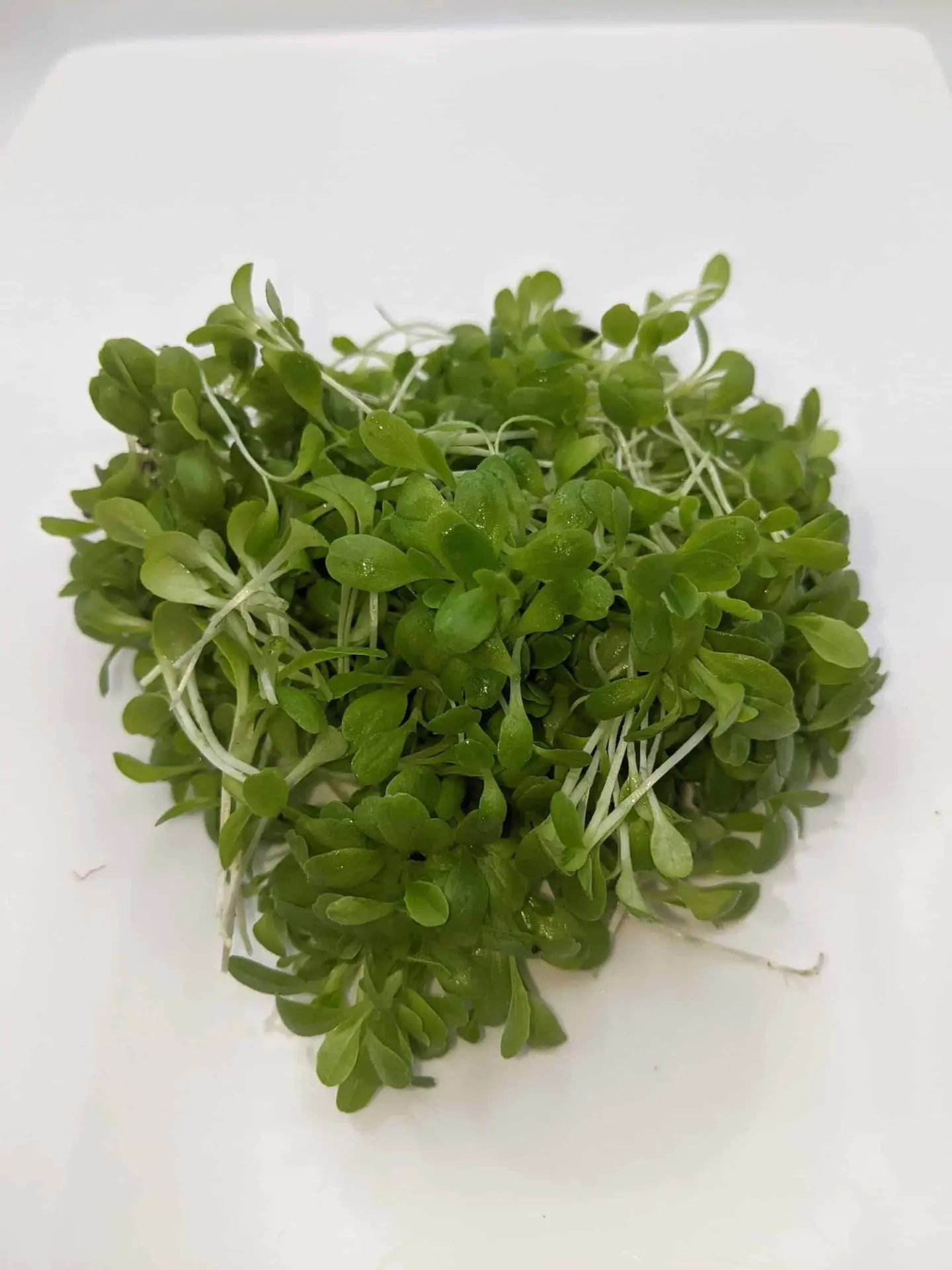Cos Microgreen Nutrition Fact Sheet

Cos Microgreen Nutrition Fact Sheet
When you think of Cos lettuce, you likely picture a staple in salads and sandwiches, known for its elongated, narrow leaves. But did you know that when harvested early, these tiny plants transform into a nutritional powerhouse known as Cos microgreens? These miniature greens are not only delightful to the palate but also offer a cornucopia of essential nutrients that can significantly enhance your overall health.
Nutritional composition
Cos microgreens, revered for their mild flavor and attractive appearance, are far more than just a culinary delight. They are packed with essential nutrients that your body craves. Let's explore their nutritional profile:
Vitamin C: Cos microgreens are a significant source of vitamin C, an antioxidant that safeguards your body's cells from the damaging effects of free radicals and bolsters your immune system. Consuming a 100-gram serving of Cos microgreens provides approximately 19% of the recommended daily vitamin C intake for adults, helping fortify your immune defenses.
Vitamin K: These microgreens aren't just about flavor; they are also rich in vitamin K, crucial for bone health and blood clotting. A 100-gram serving of Cos microgreens contains roughly 107% of the recommended daily vitamin K intake for adults, promoting strong bones and efficient wound healing.
Dietary Fiber: Cos microgreens are a superb source of dietary fiber, a carbohydrate that plays a pivotal role in supporting digestive health and reducing blood cholesterol levels. Ingesting a 100-gram serving provides around 1.4 grams of fiber, ensuring regular bowel movements and heart health.
Iron: Iron, an essential mineral for red blood cell formation and oxygen transport, is also abundant in Cos microgreens. A 100-gram serving offers approximately 11% of the recommended daily iron intake for adults, contributing to optimal oxygen transport and overall vitality.
Health Benefits Beyond Nutrition
But the benefits of Cos microgreens don't end with their nutritional content. These tiny greens offer a slew of additional health advantages:
Antioxidants: Thanks to their phenolic compounds, Cos microgreens possess potent antioxidant properties that can combat oxidative stress and reduce the risk of chronic diseases. The extent of their antioxidant activity is correlated with the concentration of phenolic compounds in the extracts.
Anti-Inflammatory: Cos microgreens contain anti-inflammatory compounds that can assist in reducing inflammation by inhibiting the production of inflammatory molecules like TNF-α and interleukin-1β in inflammatory cells. This holds promise for preventing inflammation-related chronic diseases, including cardiovascular disease and diabetes.
Antitumor Potential: While preliminary studies have suggested antitumor properties, it's important to note that these findings were derived from in vitro models. Further research is necessary to fully comprehend the impact of Cos microgreens on cancer prevention or treatment.
Cardiovascular Protection: Cos microgreens may contribute to cardiovascular health by potentially lowering blood cholesterol levels and shielding against arterial plaque formation. Additionally, the antioxidants present in these greens have been studied for their potential to reduce the risk of cardiovascular disease.
Cos microgreens' culinary versatility allows them to be integrated into a wide range of dishes. Whether as a focal ingredient or a subtle garnish, these microgreens introduce a fresh, crunchy dimension that elevates the overall culinary experience.
Growing Cos microgreens at home is a straightforward endeavor, enabling you to enjoy their freshness and nutritional benefits right at your fingertips. Regardless of whether you have a garden or a small windowsill, cultivating these greens in containers is accessible and gratifying.
In Conclusion, Cos microgreens epitomize the fusion of exquisite flavor and nutritional brilliance. Their adaptability in the kitchen, combined with a myriad of health benefits and ease of cultivation, makes them an invaluable addition to your diet. Whether you're a culinary connoisseur aiming to elevate your dishes or an individual focused on enhancing meal flavor and nutrition, Cos microgreens offer an exceptional choice. By incorporating these petite greens into your culinary repertoire, you embark on a journey that unites delectable taste and wholesome nourishment.
References:
USDA FoodData Central. Lettuce, romaine, raw. https://fdc.nal.usda.gov/fdc-app.html#/food-details/171904/nutrients
Bhaswant, M., Shanmugam, D. K., Miyazawa, T., Abe, C., & Miyazawa, T. (2023). Microgreens—A comprehensive review of bioactive molecules and health benefits. Molecules (Basel, Switzerland), 28(2), 867. https://doi.org/10.3390/molecules28020867
Hassanpour Moghadam, M., Ghasemi, Z., Sepahi, S., Rahbarian, R., Mosannen Mozaffari, H., & Mohajeri, S. A. (2020). Hypolipidemic effect of Lactuca sativa seed extract, an adjunctive treatment, in patients with hyperlipidemia: a randomized double-blind placebo-controlled pilot trial. Journal of Herbal Medicine, 23(100373), 100373. https://doi.org/10.1016/j.hermed.2020.100373
Keerthana, P. G., & Subaratinam, R. (n.d.). A Short Literature on Microgreens: Understanding their nature and Current Research. Edu.In. Retrieved September 28, 2023, from https://www.sdnbvc.edu.in/wp-content/uploads/2023/01/PAPERID-6.pdf
Kim, M. J., Moon, Y., Tou, J. C., Mou, B., & Waterland, N. L. (2016). Nutritional value, bioactive compounds and health benefits of lettuce (Lactuca sativa L.). Journal of Food Composition and Analysis: An Official Publication of the United Nations University, International Network of Food Data Systems, 49, 19–34. https://doi.org/10.1016/j.jfca.2016.03.004
Shi, M., Gu, J., Wu, H., Rauf, A., Emran, T. B., Khan, Z., Mitra, S., Aljohani, A. S. M., Alhumaydhi, F. A., Al-Awthan, Y. S., Bahattab, O., Thiruvengadam, M., & Suleria, H. A. R. (2022). Phytochemicals, nutrition, metabolism, bioavailability, and health benefits in lettuce—A comprehensive review. Antioxidants (Basel, Switzerland), 11(6), 1158. https://doi.org/10.3390/antiox11061158
Truzzi, F., Whittaker, A., Roncuzzi, C., Saltari, A., Levesque, M. P., & Dinelli, G. (2021). Microgreens: Functional food with antiproliferative cancer properties influenced by light. Foods (Basel, Switzerland), 10(8), 1690. https://doi.org/10.3390/foods10081690
Disclaimer: The information provided in this article is for educational and informational purposes only and is not intended as medical advice. It is not a substitute for professional medical advice, diagnosis, or treatment. Always seek the advice of a qualified healthcare provider with any questions you may have regarding a medical condition. The author and publisher of this article are not responsible for any adverse effects or consequences resulting from the use of any suggestions, preparations, or procedures described in this article.

